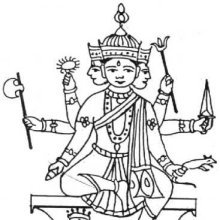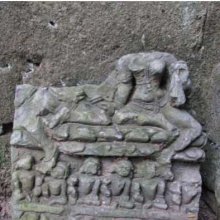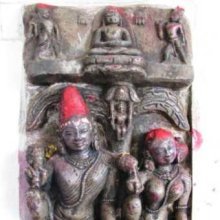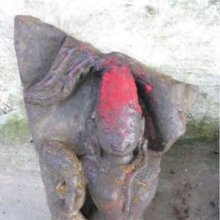Gomedha, Go-medha: 13 definitions
Introduction:
Gomedha means something in Jainism, Prakrit, Hinduism, Sanskrit, the history of ancient India, Marathi. If you want to know the exact meaning, history, etymology or English translation of this term then check out the descriptions on this page. Add your comment or reference to a book if you want to contribute to this summary article.
Images (photo gallery)
(+10 more images available)
In Jainism
General definition (in Jainism)
Source: archive.org: The Jaina IconographyGomedha (गोमेध) or Gomeda is the name of the Yakṣa accompanying Neminātha: the twenty-second of twenty-four Tīrthaṃkaras or Jinas, commonly depicted in Jaina iconography.—Neminātha’s emblem is known to be a conch-shell from the Jaina canonical texts. The Śāsana-devatās who attend upon him are Yakṣa Gomedha and Yakṣiṇī Ambikā (Digambara: and Kuṣmāṇḍinī). The Chowri-bearer, in his case, is King Ugrasena. His Kevala-tree is called Mahāveṇu or Vetasa.+
Gomedha is the Yakṣa of Ariṣṭanemi or Neminātha. The descriptions of both the sects are equal regarding the features of his three faces, six hands and vehicle of a man. In other respects, the Śvetāmbara books prescribe for his hands a citrus, axe, disc, mongoose, trident, and Śakti (spear); the Digambara texts give him similarly for his hands—a hammer (Drughaṇa), axe, staff, huit, Vajra, Varada Mudrā.

Jainism is an Indian religion of Dharma whose doctrine revolves around harmlessness (ahimsa) towards every living being. The two major branches (Digambara and Svetambara) of Jainism stimulate self-control (or, shramana, ‘self-reliance’) and spiritual development through a path of peace for the soul to progess to the ultimate goal.
India history and geography
Source: Singhi Jain Series: Ratnaprabha-suri’s Kuvalayamala-katha (history)Gomedha (गोमेध) refers to one of the sixty doctrines of different religious sects that existed in ancient India, as mentioned by Uddyotanasūri in his 8th-century Kuvalayamālā (a Prakrit Campū, similar to Kāvya poetry).—Page 203.20 f.: There is a detailed description of about 60 doctrines of different religious sects and schools of philosophy that had developed before the time of Uddyotanasūri, for example, [Agnihotra] [...]. This list of different sects of Uddyotanasūri’s may be compared with the lists given by Bāṇa in the Harṣacarita (Books 5, 8).

The history of India traces the identification of countries, villages, towns and other regions of India, as well as mythology, zoology, royal dynasties, rulers, tribes, local festivities and traditions and regional languages. Ancient India enjoyed religious freedom and encourages the path of Dharma, a concept common to Buddhism, Hinduism, and Jainism.
Languages of India and abroad
Marathi-English dictionary
Source: DDSA: The Molesworth Marathi and English Dictionarygōmēdha (गोमेध).—m (S) Sacrifice of a cow.
Source: DDSA: The Aryabhusan school dictionary, Marathi-Englishgōmēdha (गोमेध).—m Sacrifice of a cow.
Marathi is an Indo-European language having over 70 million native speakers people in (predominantly) Maharashtra India. Marathi, like many other Indo-Aryan languages, evolved from early forms of Prakrit, which itself is a subset of Sanskrit, one of the most ancient languages of the world.
Sanskrit dictionary
Source: DDSA: The practical Sanskrit-English dictionaryGomedha (गोमेध).—a cow-sacrifice; Rām.7.25.8.
Derivable forms: gomedhaḥ (गोमेधः).
Gomedha is a Sanskrit compound consisting of the terms go and medha (मेध). See also (synonyms): goyajña.
Source: Cologne Digital Sanskrit Dictionaries: Shabda-Sagara Sanskrit-English DictionaryGomedha (गोमेध).—m.
(-dhaḥ) The offering or sacrifice of a cow. E. go a cow, and medha sacrifice. medha-vadhe ādhāre ghañ . ṣaṣṭhītatpuruṣaḥ .
Source: Cologne Digital Sanskrit Dictionaries: Cappeller Sanskrit-English DictionaryGomedha (गोमेध).—[masculine] the sacrifice of a cow.
Source: Cologne Digital Sanskrit Dictionaries: Monier-Williams Sanskrit-English Dictionary1) Gomedha (गोमेध):—[=go-medha] [from go] m. (cf. gavāṃ-m) a cow-sacrifice, [Rāmāyaṇa vii, 25, 8; Varāha-purāṇa xvi]
2) [v.s. ...] Name of the attendant of the 22nd Arhat of the present Avasarpiṇī, [cf. Lexicographers, esp. such as amarasiṃha, halāyudha, hemacandra, etc.]
Source: Cologne Digital Sanskrit Dictionaries: Yates Sanskrit-English DictionaryGomedha (गोमेध):—[go-medha] (dhaḥ) 1. m. The offering or sacrifice of a cow.
Source: DDSA: Paia-sadda-mahannavo; a comprehensive Prakrit Hindi dictionary (S)Gomedha (गोमेध) in the Sanskrit language is related to the Prakrit word: Gomeha.
[Sanskrit to German]
Sanskrit, also spelled संस्कृतम् (saṃskṛtam), is an ancient language of India commonly seen as the grandmother of the Indo-European language family (even English!). Closely allied with Prakrit and Pali, Sanskrit is more exhaustive in both grammar and terms and has the most extensive collection of literature in the world, greatly surpassing its sister-languages Greek and Latin.
Kannada-English dictionary
Source: Alar: Kannada-English corpusGōmēdha (ಗೋಮೇಧ):—[noun] a sacrifice at the end of which a cow would be sacrificed.
Kannada is a Dravidian language (as opposed to the Indo-European language family) mainly spoken in the southwestern region of India.
See also (Relevant definitions)
Full-text (+5): Kometam, Gosava, Svarbhanava, Gomeha, Gaumathika, Goyajna, Gomeda, Navaratna, Vetasa, Mahavenu, Ugrasena, Maheshvara, Kankola, Vira, Kunda, Apamarga, Ambika, Kushmandi, Amra, Kushmandini.
Relevant text
Search found 17 books and stories containing Gomedha, Go-medha, Gō-mēdha, Gōmēdha; (plurals include: Gomedhas, medhas, mēdhas, Gōmēdhas). You can also click to the full overview containing English textual excerpts. Below are direct links for the most relevant articles:
Jainism in Odisha (Orissa) (by Ashis Ranjan Sahoo)
Ambika images (Koraput) < [Chapter 3: Survey of Jaina Antiquities in Odisha]
Ambika image, Phalesvara Temple, Shoradiha < [Chapter 3: Survey of Jaina Antiquities in Odisha]
Jaina Antiquities at Tarangasagarpur (Jajpur) < [Chapter 3: Survey of Jaina Antiquities in Odisha]
Trishashti Shalaka Purusha Caritra (by Helen M. Johnson)
Part 7: Nemi’s śāsanadevatās (messenger-deities) < [Chapter IX - Ariṣṭanemi’s sport, initiation, omniscience]
Jain Remains of Ancient Bengal (by Shubha Majumder)
The twenty-four Tīrthaṅkaras and their Yakṣas and Yakṣiṇīs < [Chapter 6 - Iconographic Study of Jaina Sculptural Remains]
Appendix 1 - The Position of Yakṣas and Yakṣiṇīs in Jainism
Images of Tīrthaṅkara Neminātha < [Chapter 6 - Iconographic Study of Jaina Sculptural Remains]
The Agni Purana (by N. Gangadharan)
Mahabharata (English) (by Kisari Mohan Ganguli)
The Padma Purana (by N.A. Deshpande)
Chapter 36 - Conversation between Rāma and Agastya < [Section 1 - Sṛṣṭi-khaṇḍa (section on creation)]
Chapter 244 - Rāma Goes to Heaven < [Section 6 - Uttara-Khaṇḍa (Concluding Section)]





